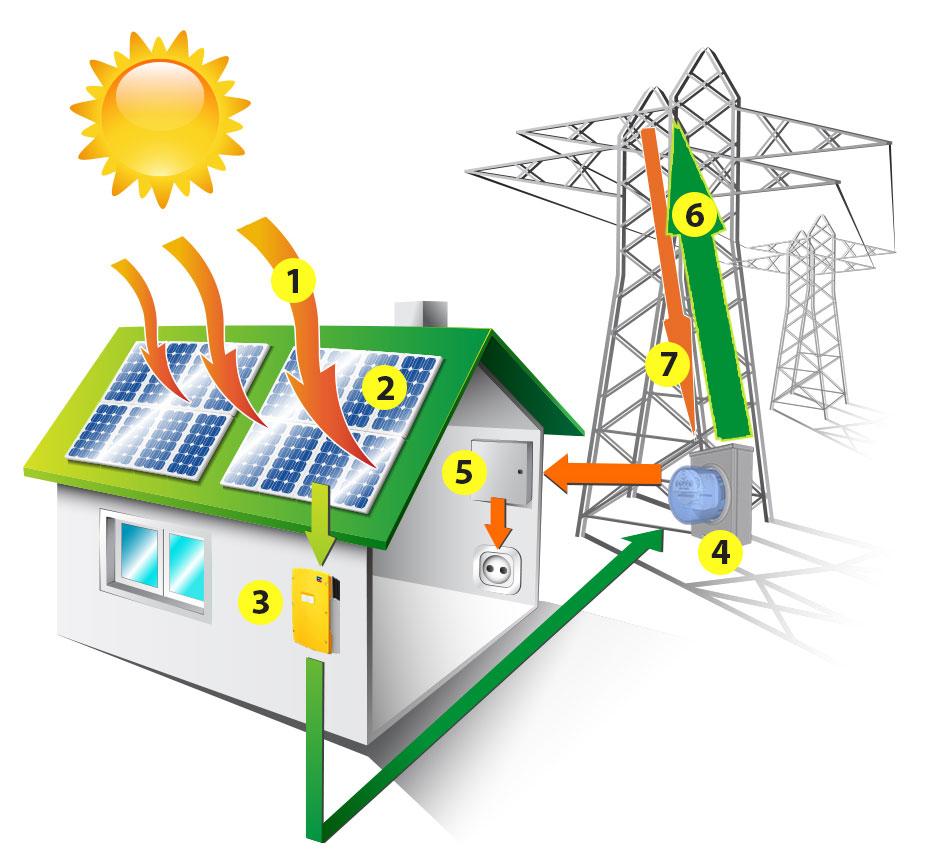01. The Energy Source
Sun provides free energy every day. Only two billionths of the Sun’s energy strikes the Earth, but, according to the experts in the field, solar energy striking the Earth in a 40-minute period is equal to all the energy human society consumes in a year.
For tropical countries like Sri Lanka solar power is the cleanest and the most cost effective energy source.
02. Solar Panels
Solar panels absorb light (reflected and diffused, as well as direct) the sun and convert photons into Direct Current (DC) electricity using photovoltaic (PV) cells. There are three (3) types of PV solar panels
- Monocrystalline silicon cells
- Polycrystalline cells
- Amorphous silicon cells
Your monthly energy usage determines how many panels need to be installed.
03. Inverter
The DC power generated from solar panels is sent to an inverter; a device that converts DC power to Alternating Current (AC).So that the electricity is compatible with the household appliances. There are three types of inverter:
- String Inverter
String inverter offers a lower initial cost per peak watt price. Easier to install since they accept DC input from multiple panels and do not need to be installed directly adjacent to individual panels. Your solar panels are arranged into groups connected by “strings.” Each string of panels is connected to a single inverter, which transforms the DC electricity produced by the panels into appliance-friendly AC electricity.
- Micro-inverters
Micro-inverters are rapidly gaining popularity, particularly for residential solar systems. Micro-inverters tend to be more expensive than string inverters or power optimizers, but their costs are falling as they become more popular.
Micro-inverters are installed on each individual panel in a solar energy system. They convert the DC electricity from your solar panels into AC electricity on your roof, with no need for a separate central inverter. In many cases the micro-inverters are integrated into the solar panel itself, but they may also be mounted next to the panel on the mounting system.
- Power optimizers
Power optimizers offer many of the same benefits as micro-inverters, and tend to be slightly more expensive. Power optimizers are often considered a compromise between more expensive micro-inverters and the standard string inverter.
Like micro-inverters, power optimizers are located at each panel, usually integrated into the panels themselves. However, instead of converting the DC electricity to AC electricity at the panel site, they “condition” the DC electricity and send it to a string inverter. This approach results in higher system efficiency than a string inverter alone.
Similar to micro-inverters, power optimizers reduce the impact of panel shading on system performance, and also offer panel performance monitoring. Systems that use optimizers are typically more affordable than those that use micro-inverters.

04. Net Meter
The net meter replaces the utility meter and records the net amount of energy generated through the PV Solar system and the amount consumed by the user. If your system produces more energy than you need, the excess power is exported to national grid. That amount of energy is deducted from your monthly bill or credited toward a future bill by utility supplier (LECO)
05. Electrical Panel
The electrical panel often called a breaker box. It receives AC power from the inverter and feed the AC power to your lights and appliances for use.
06. Excess AC Energy
With net metering, over produced or unused solar electricity is sent back into the national grid for credits and it can be used by someone else. You will be paid for the surplus electricity exported to the utility supplier’s power grid.
07. Electricity Sent from the Power Grid
Your home remains connected to the power grid to supply you with electricity.
When you need more power than your solar system produces or when the solar PV system doesn’t produce power due to climatic reasons, you can still power up using the utility supplier’s power grid.

